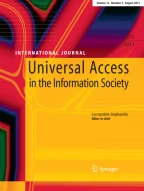Abstract
This paper presents a study investigating how the performance of motion-impaired computer users in “point and click” tasks varies with target distance (A), target width (W), and force-feedback gravity well width (GWW). Six motion-impaired users performed “point and click” tasks across a range of values for A, W, and GWW. Times were observed to increase with A, and to decrease with W. Times also improved with GWW, and, with the addition of a gravity well, a greater improvement was observed for smaller targets than for bigger ones. It was found that Fitts’ Law gave a good description of behaviour for each value of GWW, and that gravity wells reduced the effect of task difficulty on performance. A model based on Fitts’ Law is proposed, which incorporates the effect of GWW on movement time. The model accounts for 88.8% of the variance in the observed data.
Similar content being viewed by others
References
Bravo PE, LeGare M, Cook AM, Hussey SM (1990) Application of Fitts’ law to arm movements aimed at targets in people with cerebral palsy. In: Proceedings of the 13th annual conference of the Rehabilitation Engineering Society of North America. RESNA, Washington, DC, pp 21.3–21.4
Fitts PM (1954) The information capacity of the human motor system in controlling the amplitude of movement. J Exp Psychol 47:381–391
Graham ED, MacKenzie CL (1996) Physical versus virtual pointing. In: Proceedings of CHI 1996. ACM, New York, pp 292–299
Hasser C, Goldenberg A, Martin K, Rosenberg L (1998) User performance in a GUI pointing task with a low-cost force feedback computer mouse. In: Proceedings of the ASME dynamic systems and control division. American Society of Mechanical Engineers, pp 151–156
ISO 9241-9:2000(E) (2000) Ergonomic requirements for office work with visual display terminals (VDTs) - Part 9: Requirements for non-keyboard input devices, International Organisation for Standardisation, February 15, 2000
Jagacinski RJ, Repperger DW, Moran MS, Ward SL, Glass B (1980) Fitts‘ Law and the microstructure of rapid discrete movements. J Exp Psychol: Human Percep Perform 6(2):309–320
Johnson PW, Hewes J, Dropkin J, Rempel DM (1993) Office ergonomics: motion analysis of computer mouse usage. In: Proceedings of the American Industrial Hygiene Association. Fairfax, VA, pp 12–13
Keates S, Langdon P, Clarkson J, Robinson P (2000) Investigating the use of force feedback for motion-impaired users. In: Proceedings of the 6th ERCIM workshop (Florence Italy), pp 207–212
Keates S, Hwang F, Langdon P, Clarkson J, Robinson P (2002) The use of cursor measures for motion-impaired computer users. Univ Access Inform Soc 2(1):18–29
Ketcham C, Seidler R, Van Gemmert A, Stelmach G (2002) Age-related kinematic differences as influenced by task difficulty, target size, and movement amplitude. J Gerontol: Psychol Sci 57B(1):P54–P64
LoPresti E, Brienza DM, Angelo J, Gilbertson L, Sakai J (2000) Neck range of motion and use of computer head controls. In: Proceedings of ASSETS 2000 (Arlington, VA). ACM, New York, NY, pp 121–128
MacKenzie IS (1992) Fitts’ law as a research and design tool in human–computer interaction. Hum–comput Interact 7:91–139
MacKenzie IS, Ware C (1993) Lag as a determinant of human performance in interactive systems. In: Proceedings of Interchi 1993, ACM, New York, NY, pp. 488–493
MacKenzie IS (1995) Movement time prediction in human–computer interfaces. In: Baecker RM, Buxton WAS, Grudin J, Greenberg S (eds.) Readings in human–computer interaction. Kaufmann, Los Altos, pp 483–493
MacKenzie IS, Kauppinen T, Silfverberg M (2001) Accuracy measures for evaluating computer pointing devices. In: Proceedings of CHI 2001 (Seattle WA). ACM, New York, pp 9–15
MacKenzie IS, Soukoreff RW (2003) Card, English, and Burr (1978) – 25 years later. In: Extended Abstracts of CHI 2003 (Ft. Lauderdale, FL). ACM, New York, pp 760–761
McGuffin M, Balakrishnan R (2002) Acquisition of expanding targets. In: Proceedings of CHI 2002 (Minneapolis, MN). ACM, New York, pp 57–64
Mithal AK, Douglas S (1996) Differences in movement microstructure of the mouse and finger-controlled isometric joystick. In: Proceedings of CHI 1996 (Vancouver, BC). ACM, New York, pp 300–307
Oakley I, McGee MR, Brewster SA, Gray PD (2000) Putting the feel in look and feel. In: Proceedings of CHI 2000 (The Hague). ACM, New York, pp 415–422
Rao RS, Seliktar R, Rahman T (2000) Evaluation of an isometric and a position joystick in a target acquisition task for individuals with cerebral palsy. IEEE T Rehabil Eng 8 (2):118–125
Trewin S, Pain H (1999) Keyboard and mouse errors due to motor disabilities. Int J Hum-Comput Stud 50(2):109–144
Walker N, Meyer DE, Smelcer JB (1993) Spatial and temporal characteristics of rapid cursor-positioning movements with electromechanical mice in human-computer interaction. Hum Factors 35(3):431–445
Zhai S, Conversy S, Beaudouin-Lafon M, Guiard Y (2003) Human on-line response to target expansion. In: Proceedings of CHI 2003 (Fort Lauderdale, FL). ACM, New York, pp. 177–184
Acknowledgements
The authors thank the volunteers and staff of the Papworth Trust. We also wish to thank one particular reviewer for a detailed and helpful review. This work is funded by the Canadian Cambridge Trust, NSERC, and the EPSRC.
Author information
Authors and Affiliations
Corresponding author
Rights and permissions
About this article
Cite this article
Hwang, F., Keates, S., Langdon, P. et al. Movement time for motion-impaired users assisted by force-feedback: effects of movement amplitude, target width, and gravity well width. Univ Access Inf Soc 4, 85–95 (2005). https://doi.org/10.1007/s10209-005-0114-5
Published:
Issue Date:
DOI: https://doi.org/10.1007/s10209-005-0114-5
